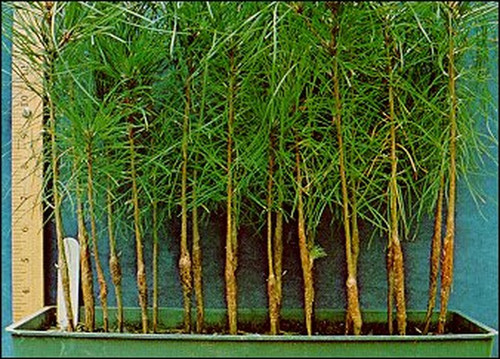The White Pine Tree
The Eastern White Pine Tree, Pinus Strobus, is a lovely arboreal plant, useful in outdoor landscaping for its attractive qualities to wildlife and its beautiful appearance. The White Pine Tree is hardy. The needles on the plant are a blue-green color, and the tree itself grows to vast heights. This incredible plant can grow up to 135 feet tall. However, the more domesticated varieties of the White Pine Tree rarely exceed sizes of 80 feet tall. In terms of width, this particular tree usually grows outward anywhere from 20 to 40 feet around. The tree is appreciated aesthetically for its full coverage, serving as an excellent privacy shade. It also blocks the wind quite well because of its density in foliage.
Planting Bare Root White Pine Trees
To plant the Eastern White Pine Tree, it is recommended that you plant in moist soils.
The root system is rather spread out, so it is advisable to produce this lovely tree in soils that drain quickly. You can find the tree growing best in Hardiness Zones 3–8. Should it be necessary, the tree can also sustain being planted in dry soils. This remarkably adaptable tree has even been known to grow in bogs or swamps. As long as it is produced and maintained well, this plant will grow rather quickly. Sometimes, the tree even grows more than 2 feet per year.
Sunlight
This sun-loving tree prefers to be planted in full sun but also can sustain partial shade environments. The tree should receive four uninterrupted hours of direct sun every single day to grow to full health.
Pine Cones
This tree is known for producing a lovely seed pod that is known as a pinecone. These charming pinecones may grow anywhere from 3 to 8 inches in length. These are slightly curved and are embellished with small, smooth scales.
Host for Wildlife
There are a variety of animal wildlife creatures who enjoy the benefits of the White Pine Tree. Black bears and rabbits are known to favor the pine tree's seeds. Beavers and mice even sometimes eat the actual bark of the tree. It is known that these pine trees provide sites for many different birds to nest in. Woodpeckers, grackles, and nuthatches have been known to inhabit these trees with their nests.
This is just a limited list of the extensive list of wildlife creatures who appreciate the White Pine Tree benefits. This is a genuinely exceptional plant in terms of its contribution to local wildlife and the surrounding ecosystem. In this way, the tree is notably beneficial to the landscaper because it will attract wildlife. This will bring an entirely new appeal to the landscape design concept incorporating this tree because the homeowner or renter will enjoy the sight of beautiful animal wildlife, incredibly colorful birds. It is also possible that it could cause a run-in with sighting a beaver or other mammal.
The Eastern White Pine Tree is a charming tree known for its contribution to wildlife and its benefits in landscaping .
It grows to notable heights, can thrive in many soil types, enjoys direct sunlight, and produces lovely pine cones. Wildlife adores this particular tree for offering food in the form of seeds and bark. They also appreciate the tree for providing nesting sites for their young. This is a truly remarkable plant that makes a stunning addition to any outdoor landscaping design, including the home or garden exterior. The tree can be placed close to any other design element of the landscape layout, as long as it is given ample room for its rooting system. This means that it is likely to fit in quite well with other types of plants that can be placed next to the tree.
White Pine Tree Seedlings for sale online at Perennial Nursery.
White Pine trees are shipped bare root.
-
Review
I received the trees on Monday and planted them on Tuesday. The roots were full of ice. The trees had yellow spots on them and I am hoping they will not have problem They appeared to be stressed out.











